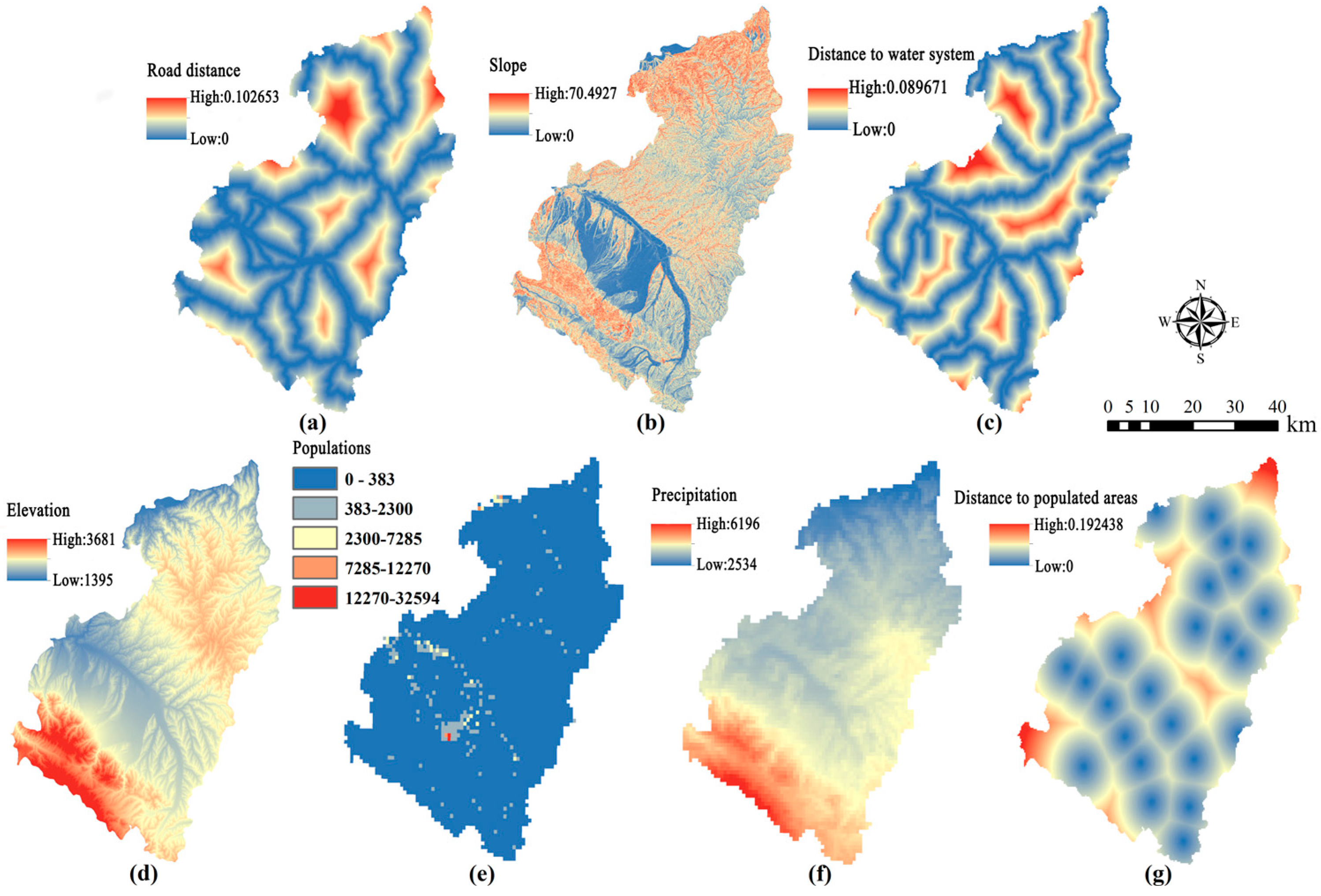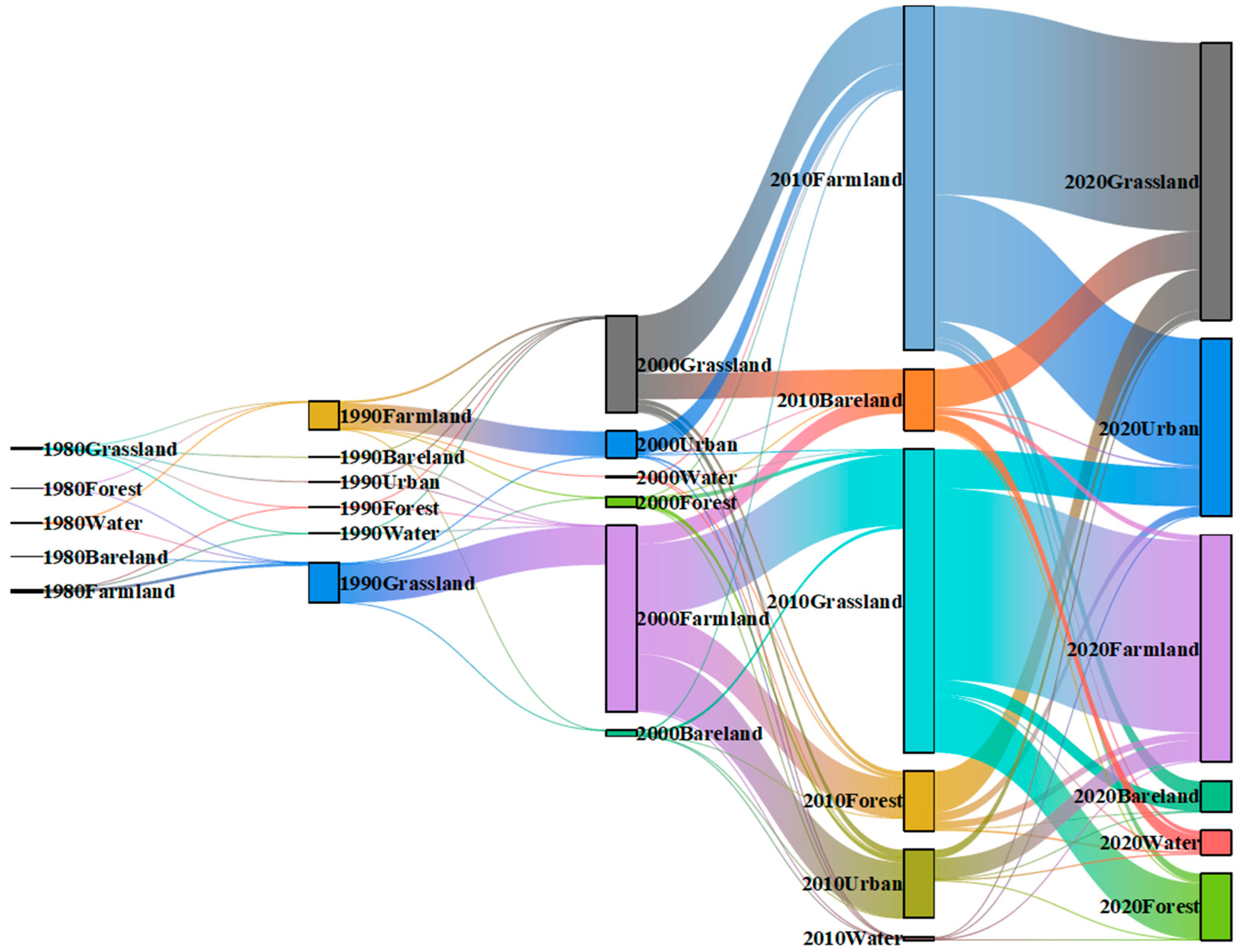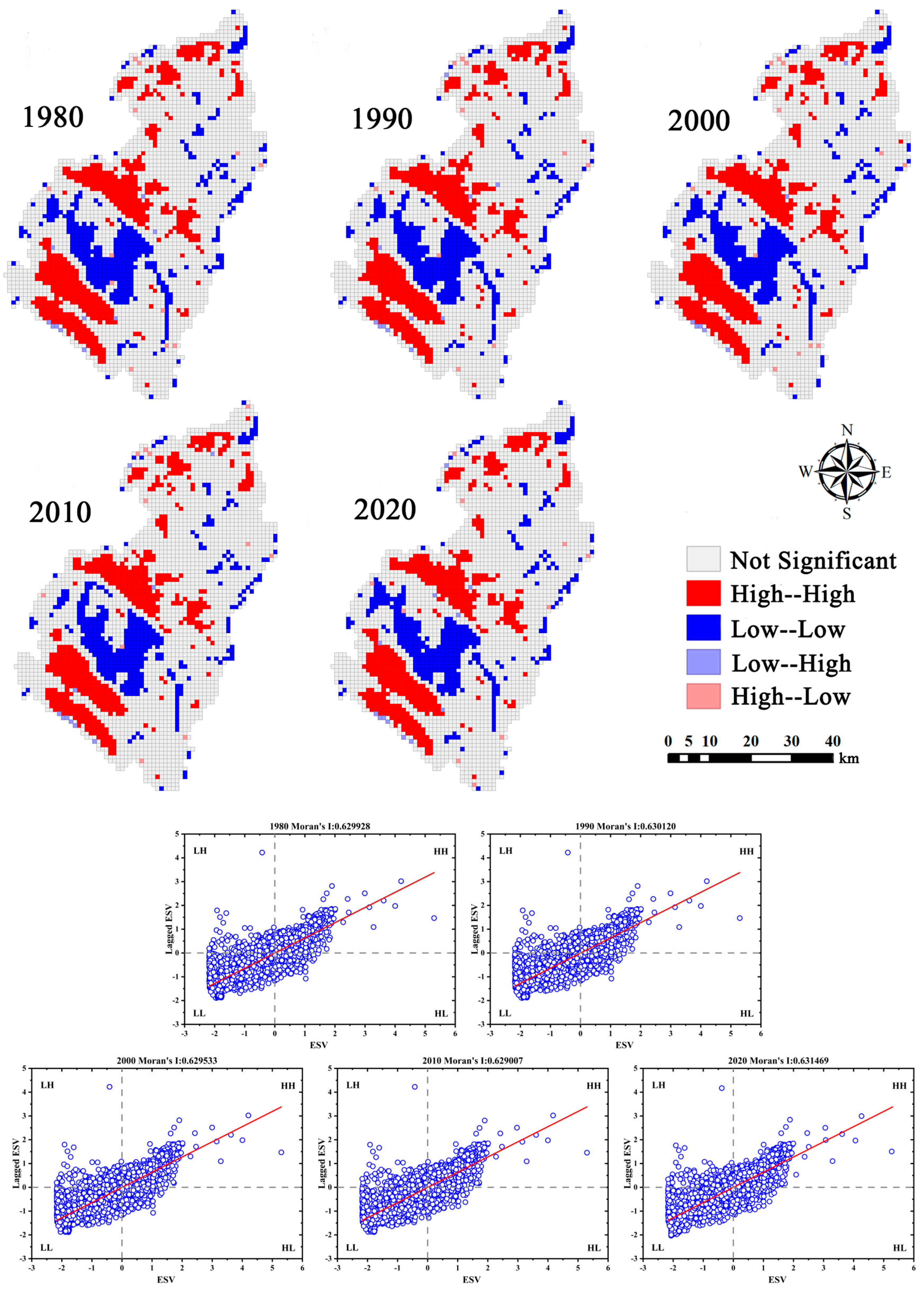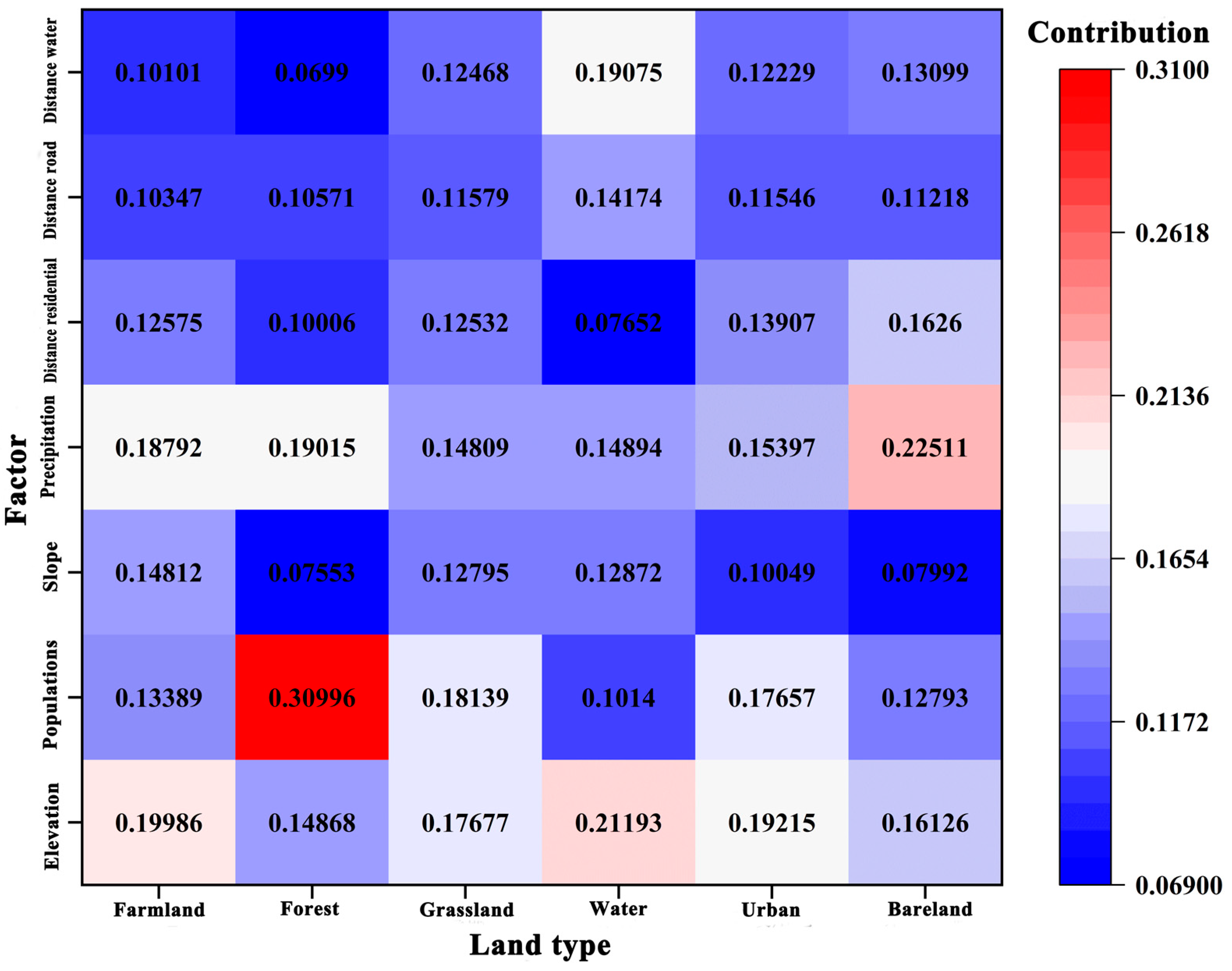Analysis of Factors Influencing the Ecosystem Service Value in Yuzhong County and Multi-Scenario Predictions
Abstract
:1. Introduction
2. Study Area and Data Sources
2.1. Overview of the Study Area
2.2. Data Sources
3. Research Methods
3.1. Unit Area Equivalent Factor Method
3.2. Spatial Autocorrelation Analysis
3.3. PLUS Prediction Model and Multi-Scenario Simulation
4. Results Analysis
4.1. Land Cover Change Analysis
4.2. Spatiotemporal Evolution of Ecosystem Service Value
4.3. Spatial Clustering Characteristics of Ecosystem Service Values
4.4. Analysis of the Drivers of Ecosystem Service Value
4.5. Multi-Scenario Prediction of Ecosystem Service Value
5. Discussion
5.1. Ecological Service Value Evolution and Driving Forces Analysis
5.2. Ecological Service Value Multi-Scenario Forecast Analysis
5.3. Limitations and Future Research Directions
6. Conclusions
Author Contributions
Funding
Data Availability Statement
Conflicts of Interest
References
- Song, J.; Liu, J.; Zhang, X.; Chen, X.; Shang, Y.; Gao, F. Spatio-temporal fluctuation analysis of ecosystem service values in northeast china over long time series: Based on bayesian hierarchical modeling. Land 2024, 13, 833. [Google Scholar] [CrossRef]
- Zhang, B.; Feng, Q.; Li, Z.; Lu, Z.; Zhang, B.; Cheng, W. Land Use/Cover-related ecosystem service value in fragile ecological environments: A case study in hexi region, China. Remote Sens. 2024, 16, 563. [Google Scholar] [CrossRef]
- Ding, R.; Li, Y.; Zhao, C.; Chen, J.; Zhu, W. Scenario simulation and driving force analysis of ecosystem service values based on land Use/Cover in the tumen river basin, China. Sustainability 2024, 16, 399. [Google Scholar] [CrossRef]
- Quan, L.; Jin, S.; Chen, J.; Li, T. Evolution and driving forces of ecological service value in anhui based on landsat land use and land cover change. Remote Sens. 2024, 16, 269. [Google Scholar] [CrossRef]
- Li, Q.; Liu, Y.; Jiao, H.; He, Q. Spatiotemporal analysis of the impacts of land use change on ecosystem service value: A case from Guiyang, China. Land 2024, 13, 211. [Google Scholar] [CrossRef]
- Tang, H.; Halike, A.; Yao, K.; Wei, Q.; Yao, L.; Tuheti, B.; Duan, Y. Ecosystem service valuation and multi-scenario simulation in the ebinur lake basin using a coupled GMOP-PLUS model. Sci. Rep. 2024, 14, 5071–5089. [Google Scholar] [CrossRef] [PubMed]
- Qi, B.; Yu, M.; Li, Y. Multi-scenario prediction of land-use changes and ecosystem service values in the lhasa river basin based on the FLUS-markov model. Land 2024, 13, 597. [Google Scholar] [CrossRef]
- Shu, R.; Wang, Z.; Guo, N.; Wei, M.; Zou, Y.; Hou, K. Multi-scenario land use optimization simulation and ecosystem service value estimation based on fine-scale land survey data. Land 2024, 13, 557. [Google Scholar] [CrossRef]
- Peng, S.Z.; Ding, Y.X.; Wen, Z.M.; Chen, Y.M.; Cao, Y.; Ren, J.Y. Spatiotemporal change and trend analysis of potential evapotranspiration over the Loess Plateau of China during 2011–2100. Agric. For. Meteorol. 2017, 233, 183–194. [Google Scholar] [CrossRef]
- Huang, G.; Feng, S.; Hu, C. A study of the spatiotemporal evolution patterns and coupling coordination between ecosystem service values and habitat quality in diverse scenarios: The case of chengdu metropolitan area, China. Sustainability 2024, 16, 3741. [Google Scholar] [CrossRef]
- Li, W.; Chen, X.; Zheng, J.; Zhang, F.; Yang, Y.; Hai, W.; Liu, L. A multi-scenario simulation and dynamic assessment of the ecosystem service values in key ecological functional areas: A case study of the Sichuan province, China. Land 2024, 13, 468. [Google Scholar] [CrossRef]
- Chang, Y.; Qu, H.; Zhang, S.; Luo, G. Assessment of uncertainties in ecological risk based on the prediction of land use change and ecosystem service evolution. Land 2024, 13, 535. [Google Scholar] [CrossRef]
- Zhi, Z.; Liu, F.; Chen, Q.; Zhou, Q.; Ma, W. Study on the urban expansion of typical tibetan plateau valley cities and changes in their ecological service value: A case study of Xining, China. Sustainability 2024, 16, 4537. [Google Scholar] [CrossRef]
- Hong, X.; Peng, Q.; Zheng, R.; Lin, W.; Fan, S.; Su, K. Evaluating the spatial evolution of the eco-economy harmony in anxi county, china, based on ecosystem services value. Sustainability 2024, 16, 1491. [Google Scholar] [CrossRef]
- Akbar, A.; Abulizi, A.; Erken, R.; Yu, T. Driving mechanisms of spatial differentiation in ecosystem service value in opencast coal mines in arid areas: A case study in the zhundong economic and technological development zone. Land 2024, 13, 623. [Google Scholar] [CrossRef]
- Liang, S.; Yang, F.; Zhang, J.; Xiong, S.; Xu, Z. Assessment and management zoning of ecosystem service trade-Off/Synergy based on the Social–Ecological balance: A case of the chang-zhu-tan metropolitan area. Land 2024, 13, 127. [Google Scholar] [CrossRef]
- Zhang, S.; Wang, Y.; Xu, W.; Sheng, Z.; Zhu, Z.; Hou, Y. Analysis of spatial and temporal variability of ecosystem service values and their spatial correlation in Xinjiang, China. Remote Sens. 2023, 15, 4861. [Google Scholar] [CrossRef]
- Zhu, S.; Zhao, Y.; Huang, J.; Wang, S. Analysis of spatial-temporal differentiation and influencing factors of ecosystem services in resource-based cities in semiarid regions. Remote Sens. 2023, 15, 871. [Google Scholar] [CrossRef]
- Peng, Q.; Wu, D.; Lin, W.; Fan, S.; Su, K. Dynamic land-use patterns and the associated impacts on ecosystem services value in Putian city, China. Appl. Sci. 2024, 14, 4554. [Google Scholar] [CrossRef]
- Fu, Y.; Cui, X.; Zhao, J.; Zhang, C.; Yan, L. Estimation of ecological compensation standard based on ecological service value calculation. IOP Conf. Ser. Earth Environ. Sci. 2021, 647, 012161. [Google Scholar] [CrossRef]
- Guan, Y.; Li, X.; Li, S.; Sun, H.; Liu, H. Effect of urban fringes green space fragmentation on ecosystem service value. PLoS ONE 2022, 17, e0263452. [Google Scholar] [CrossRef] [PubMed]
- Huang, L.; He, C.; Wang, B. Study on the spatial changes concerning ecosystem services value in lhasa river basin, China. Environ. Sci. Pollut. Res. 2022, 29, 7827–7843. [Google Scholar] [CrossRef] [PubMed]
- Gu, X.; Long, A.; Liu, G.; Yu, J.; Wang, H.; Yang, Y.; Zhang, P. Changes in ecosystem service value in the 1 km lakeshore zone of poyang lake from 1980 to 2020. Land 2021, 10, 951. [Google Scholar] [CrossRef]











| Ecosystem Classification | Provisioning Services | Regulating Services | Supporting Services | Cultural Services |
|---|---|---|---|---|
| Farmland | 99.84 | 6622.38 | 1874.68 | 166.39 |
| Forest | 5025.02 | 57,782.23 | 20,477.25 | 4115.42 |
| Grassland | 4548.04 | 44,398.80 | 15,463.32 | 4586.86 |
| Water | 14,731.20 | 150,334.74 | 9695.08 | 4819.81 |
| Urban | 0.00 | 0.00 | 0.00 | 2251.83 |
| Bareland | 66.56 | 976.16 | 332.78 | 66.56 |
| Farmland | Forest | Grassland | Water | Urban | Bareland | |
|---|---|---|---|---|---|---|
| 2020 | 1,058,735 | 235,789 | 2,175,624 | 23,751 | 123,636 | 40,246 |
| Natural Development 2030 | 1,031,500 | 237,705 | 2,166,700 | 28,488 | 158,744 | 34,644 |
| Farmland Protection 2030 | 1,076,620 | 237,806 | 2,146,250 | 27,950 | 134,765 | 34,390 |
| Economic Development 2030 | 1,015,067 | 237,433 | 2,162,341 | 28,195 | 180,329 | 34,416 |
Disclaimer/Publisher’s Note: The statements, opinions and data contained in all publications are solely those of the individual author(s) and contributor(s) and not of MDPI and/or the editor(s). MDPI and/or the editor(s) disclaim responsibility for any injury to people or property resulting from any ideas, methods, instructions or products referred to in the content. |
© 2025 by the authors. Licensee MDPI, Basel, Switzerland. This article is an open access article distributed under the terms and conditions of the Creative Commons Attribution (CC BY) license (https://creativecommons.org/licenses/by/4.0/).
Share and Cite
Yan, J.; Zhang, G.; Wang, W.; Guo, Z.; Li, J.; Yao, X.; Gao, P.; Li, Q.; Zhang, M.; Song, M. Analysis of Factors Influencing the Ecosystem Service Value in Yuzhong County and Multi-Scenario Predictions. Land 2025, 14, 833. https://doi.org/10.3390/land14040833
Yan J, Zhang G, Wang W, Guo Z, Li J, Yao X, Gao P, Li Q, Zhang M, Song M. Analysis of Factors Influencing the Ecosystem Service Value in Yuzhong County and Multi-Scenario Predictions. Land. 2025; 14(4):833. https://doi.org/10.3390/land14040833
Chicago/Turabian StyleYan, Jixuan, Gengxin Zhang, Wenning Wang, Zichen Guo, Jie Li, Xiangdong Yao, Pengcheng Gao, Qiang Li, Meihua Zhang, and Miao Song. 2025. "Analysis of Factors Influencing the Ecosystem Service Value in Yuzhong County and Multi-Scenario Predictions" Land 14, no. 4: 833. https://doi.org/10.3390/land14040833
APA StyleYan, J., Zhang, G., Wang, W., Guo, Z., Li, J., Yao, X., Gao, P., Li, Q., Zhang, M., & Song, M. (2025). Analysis of Factors Influencing the Ecosystem Service Value in Yuzhong County and Multi-Scenario Predictions. Land, 14(4), 833. https://doi.org/10.3390/land14040833





